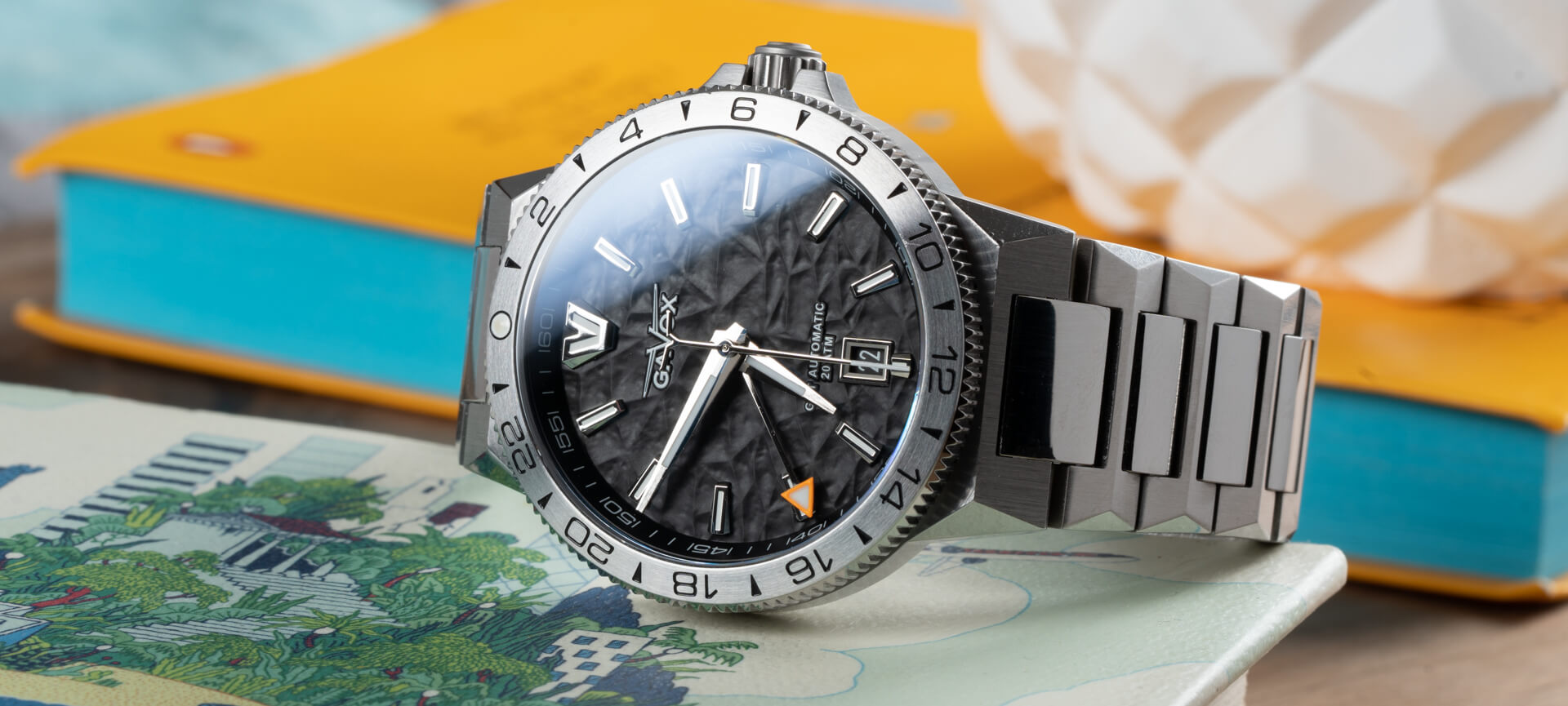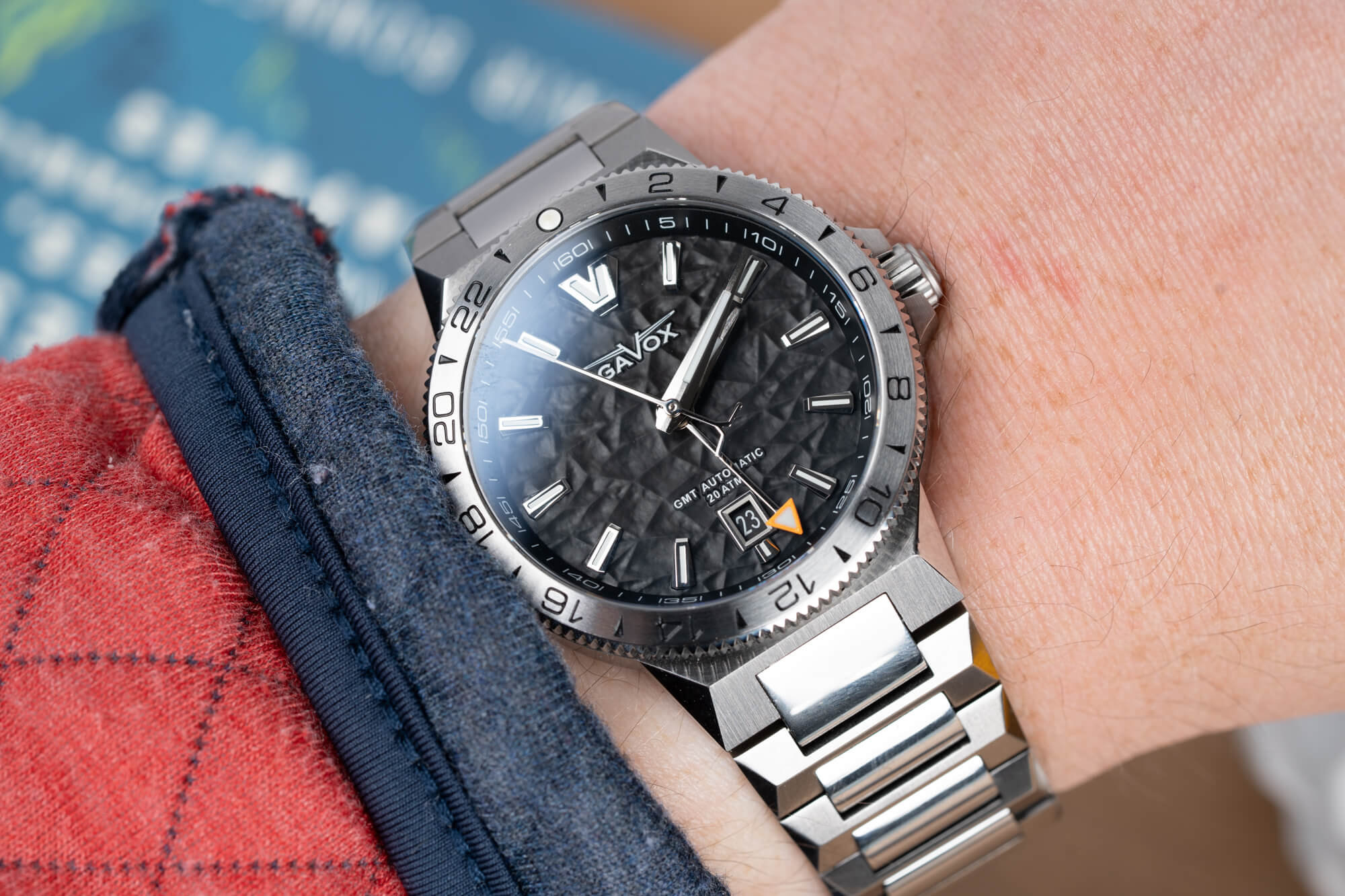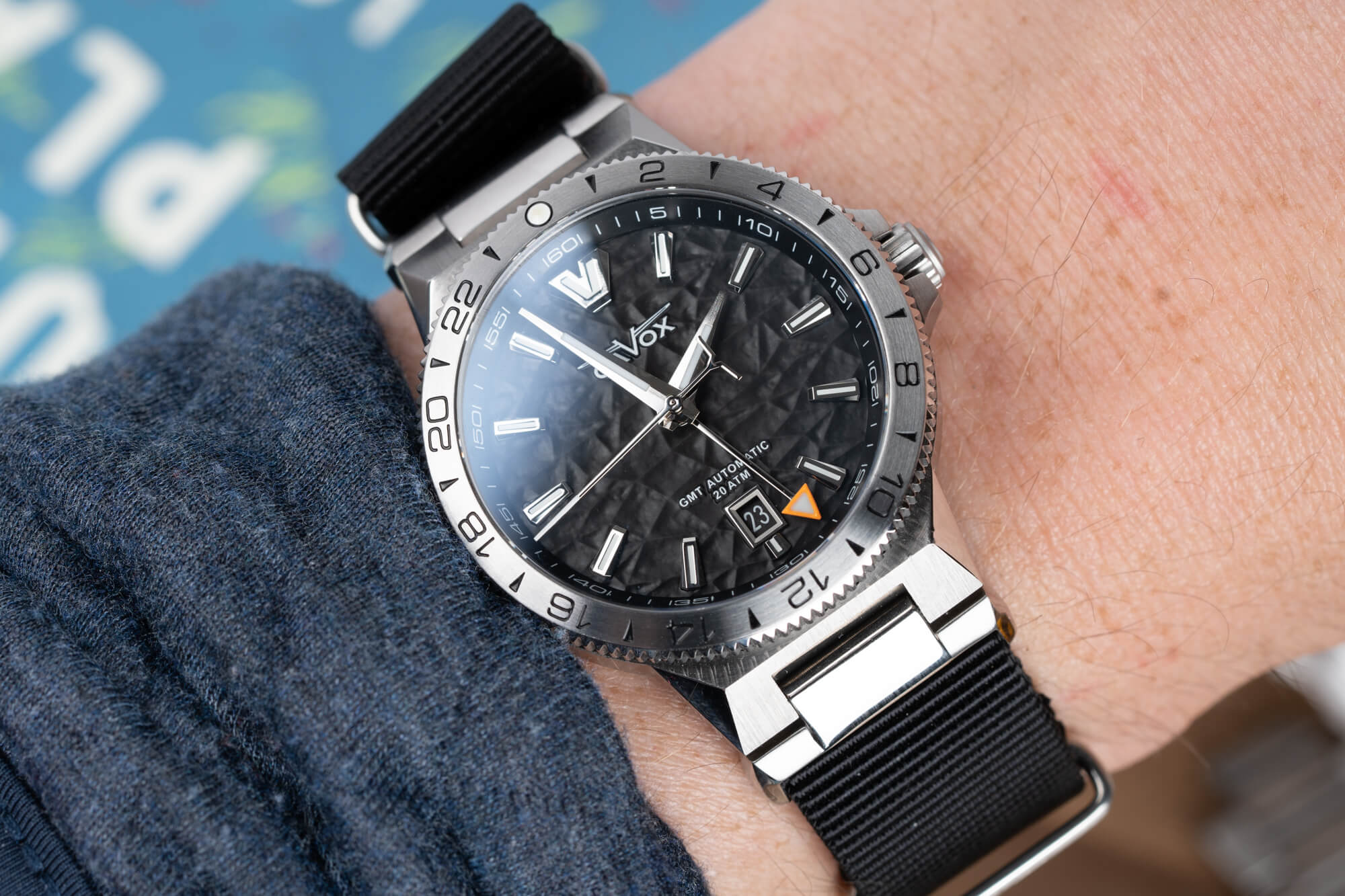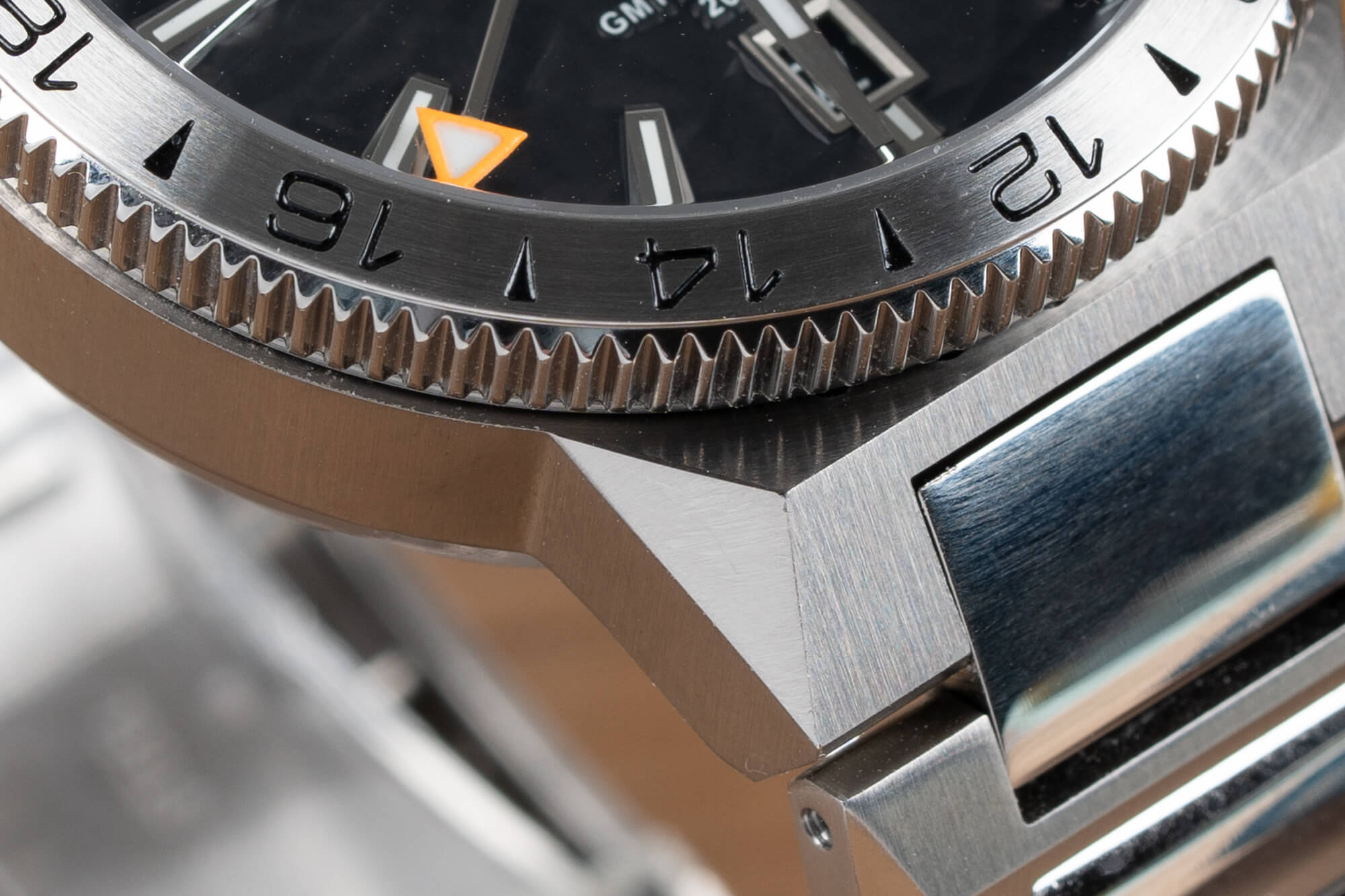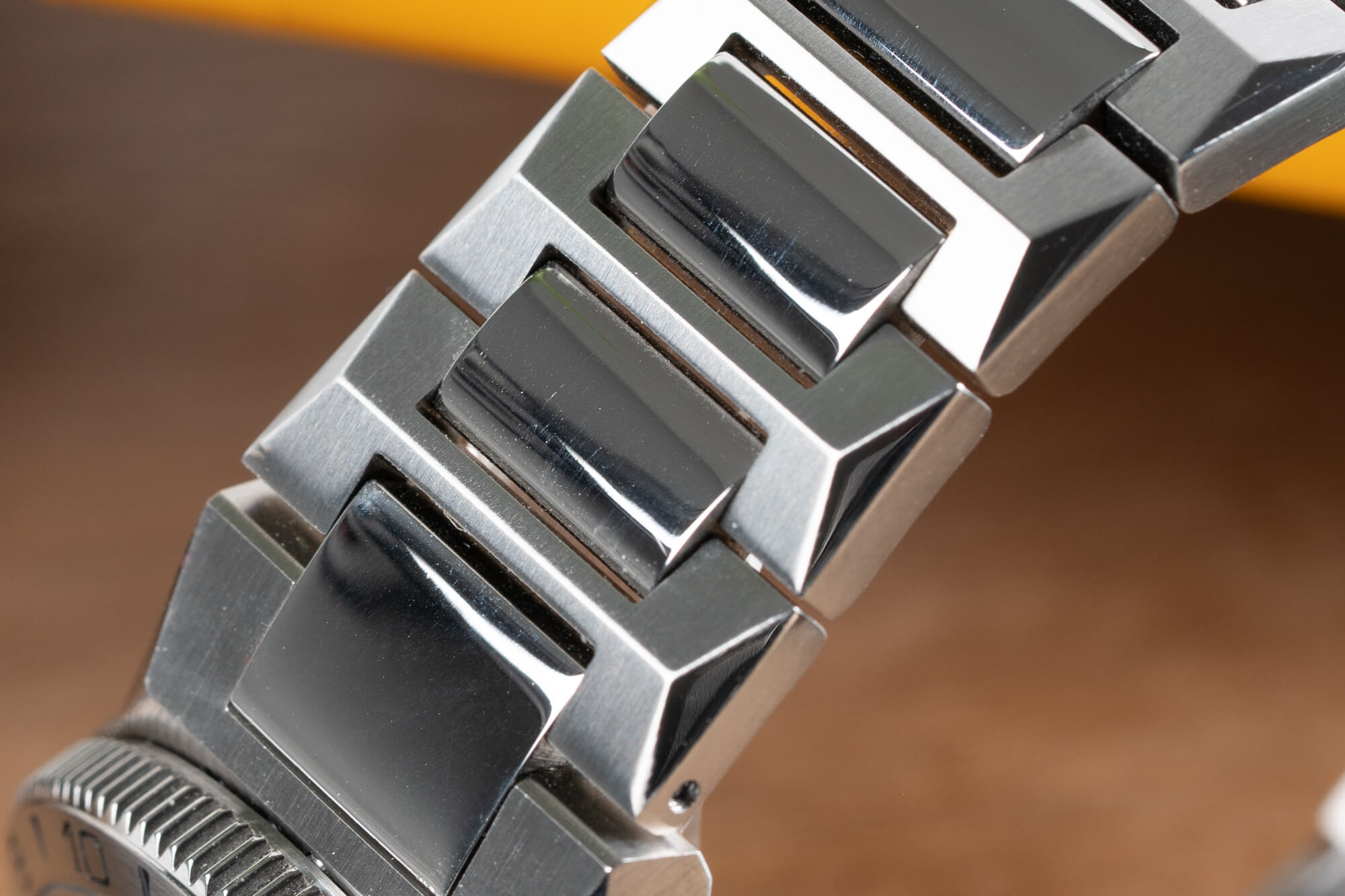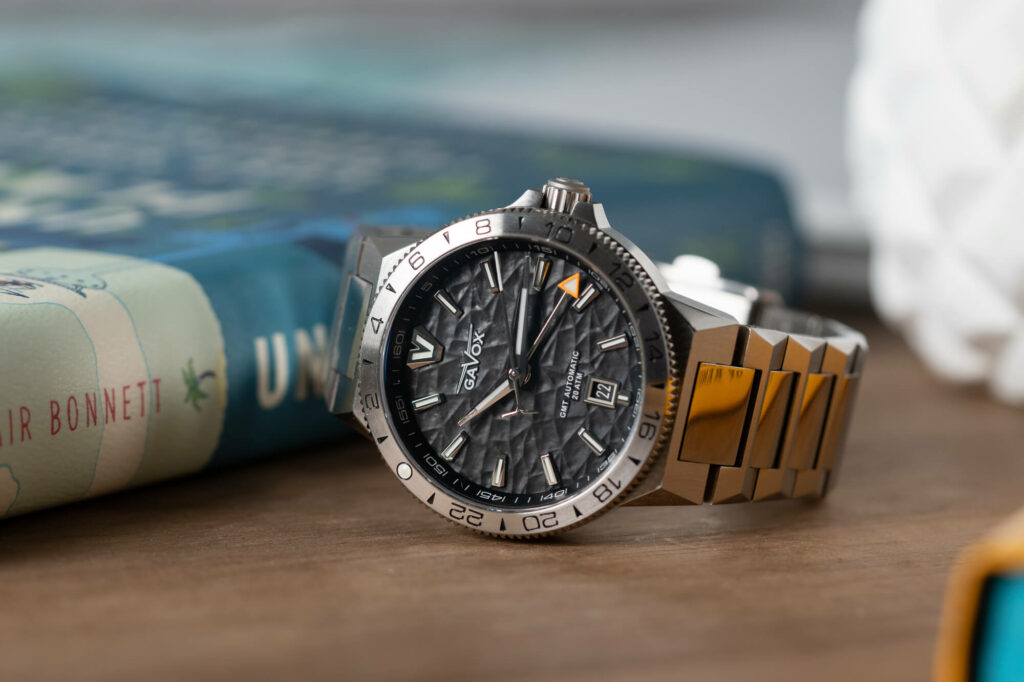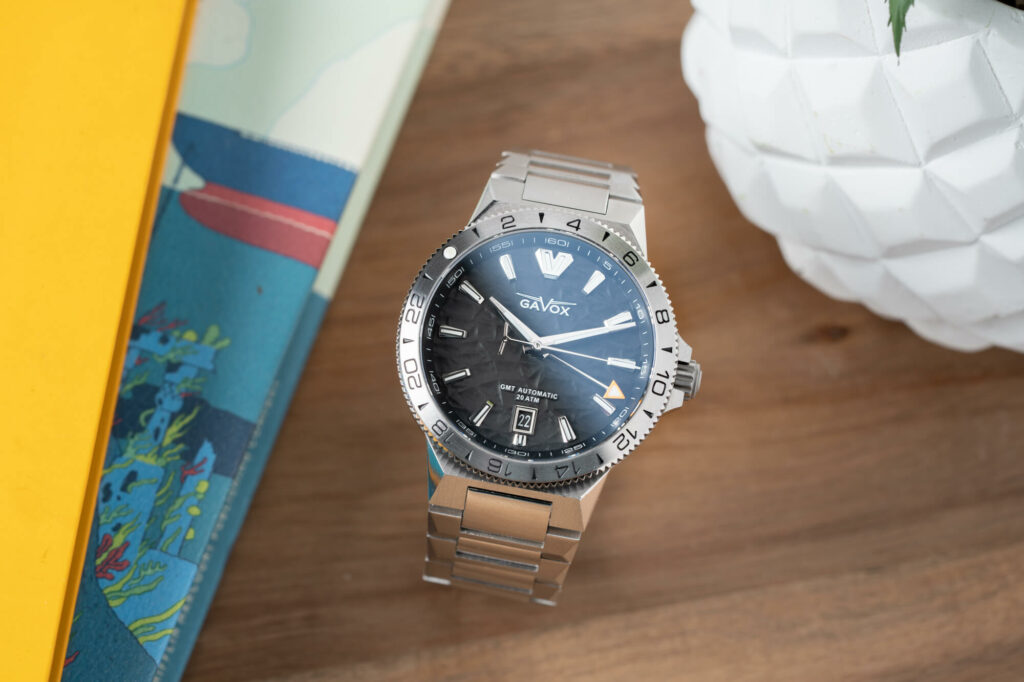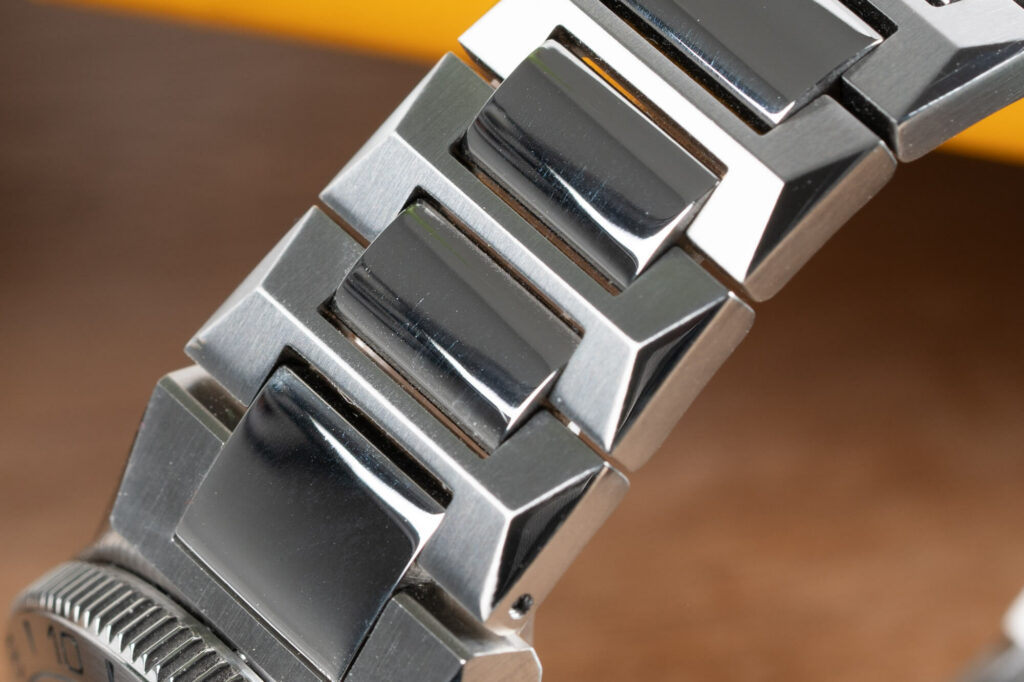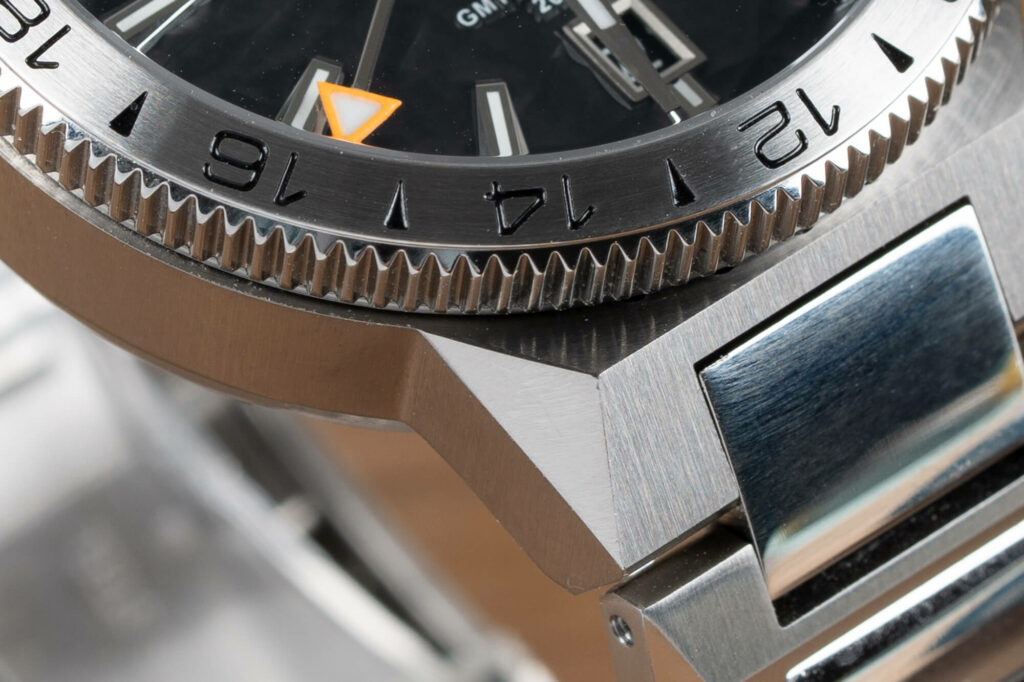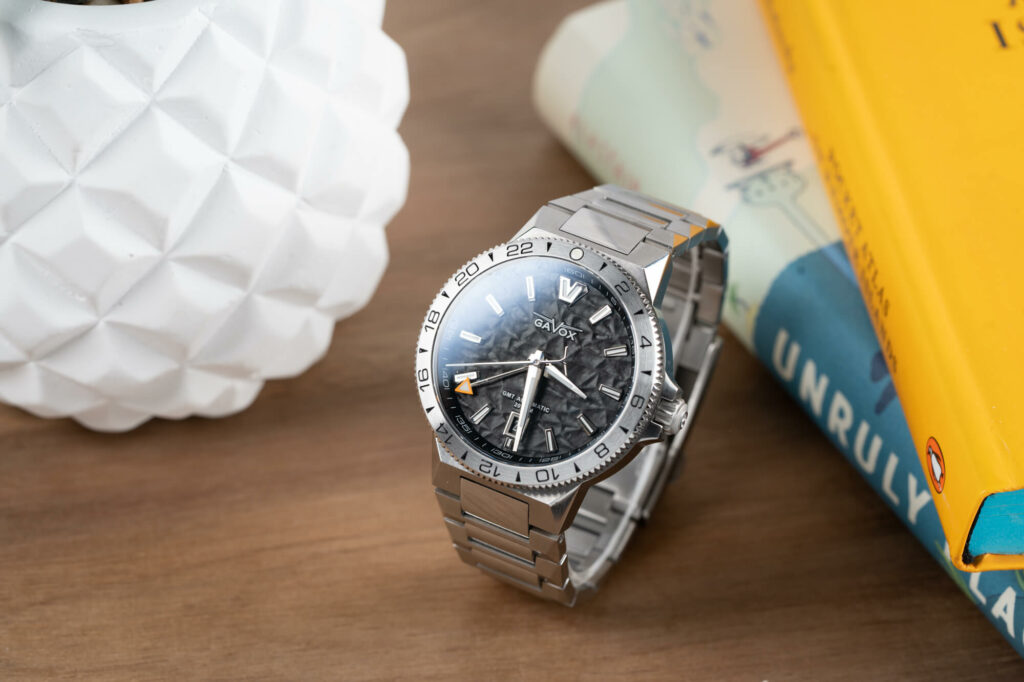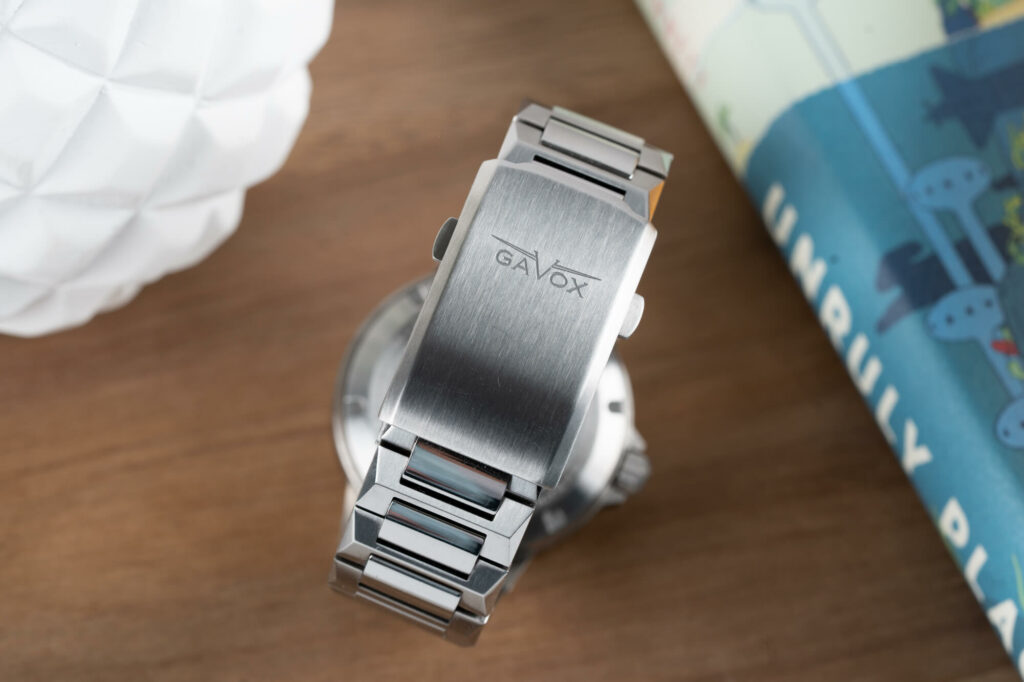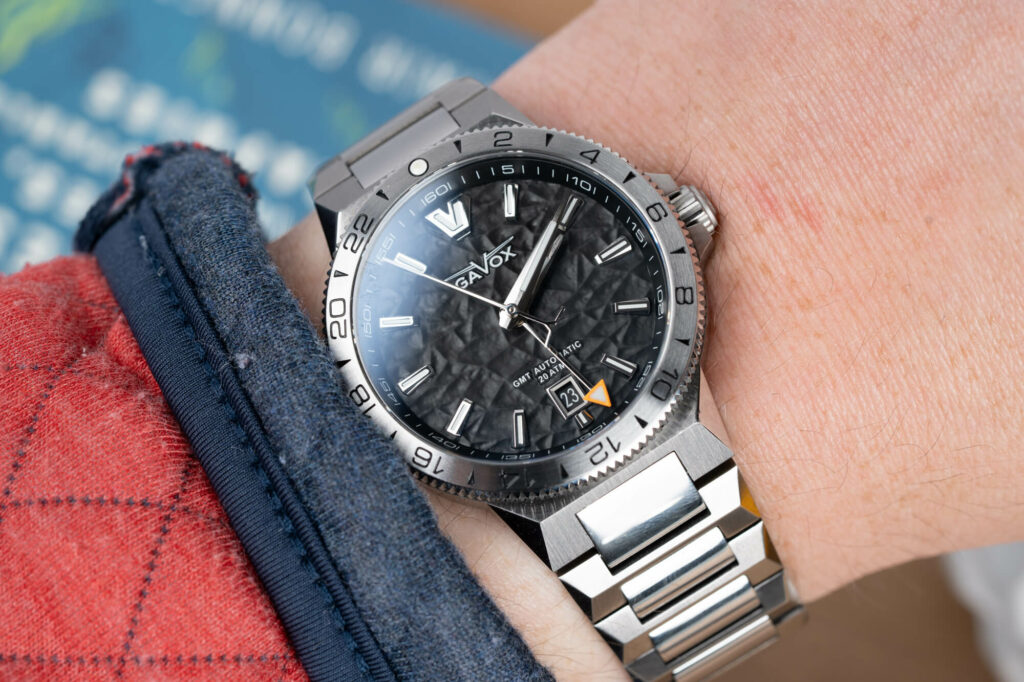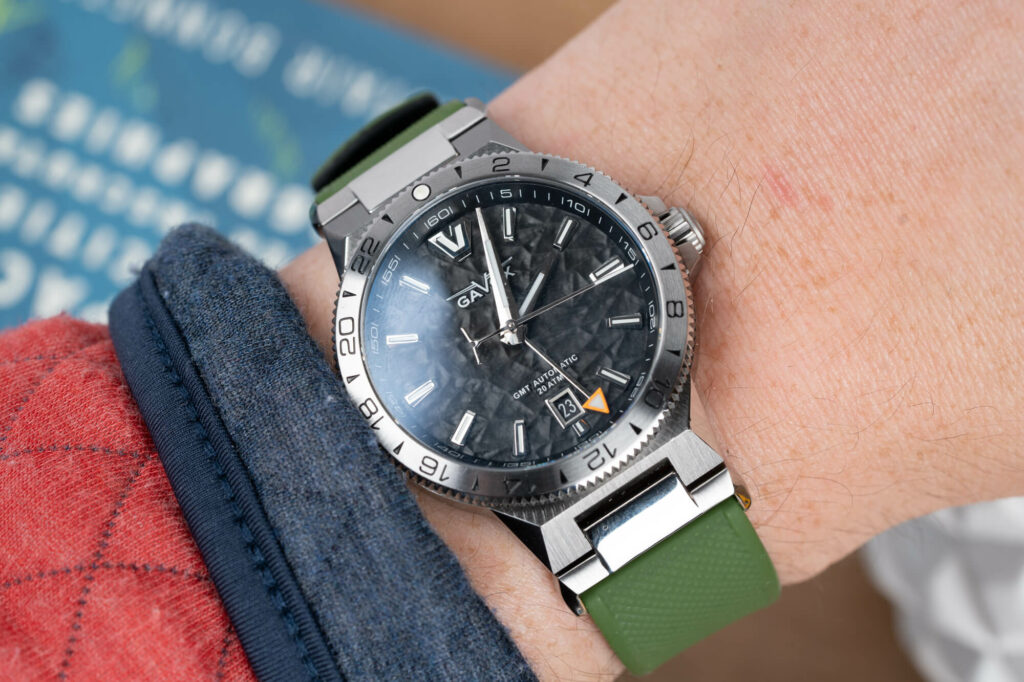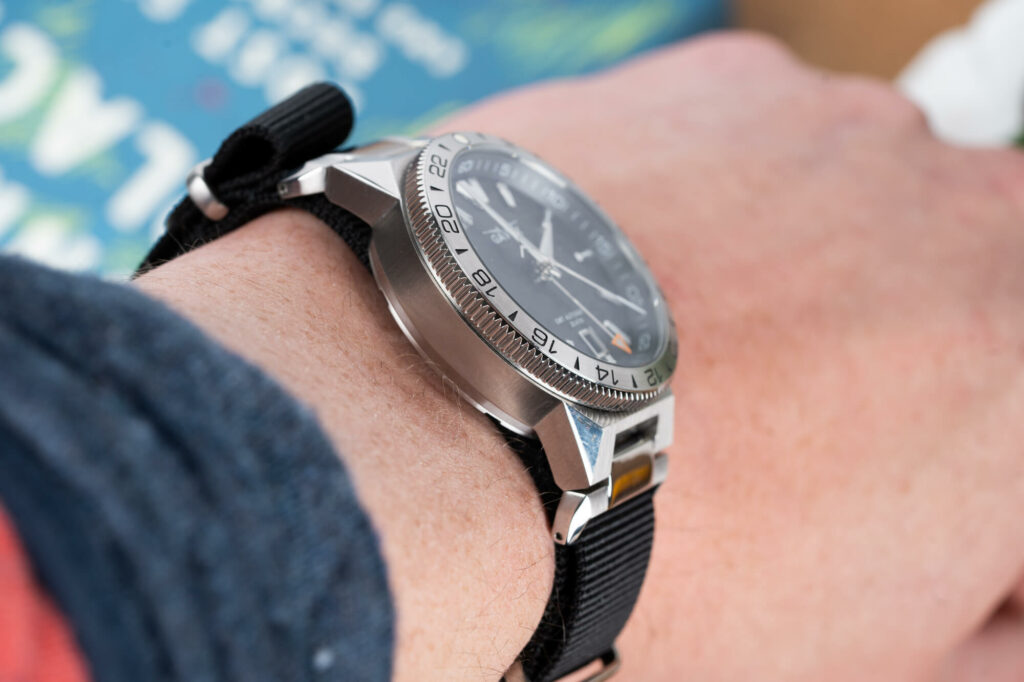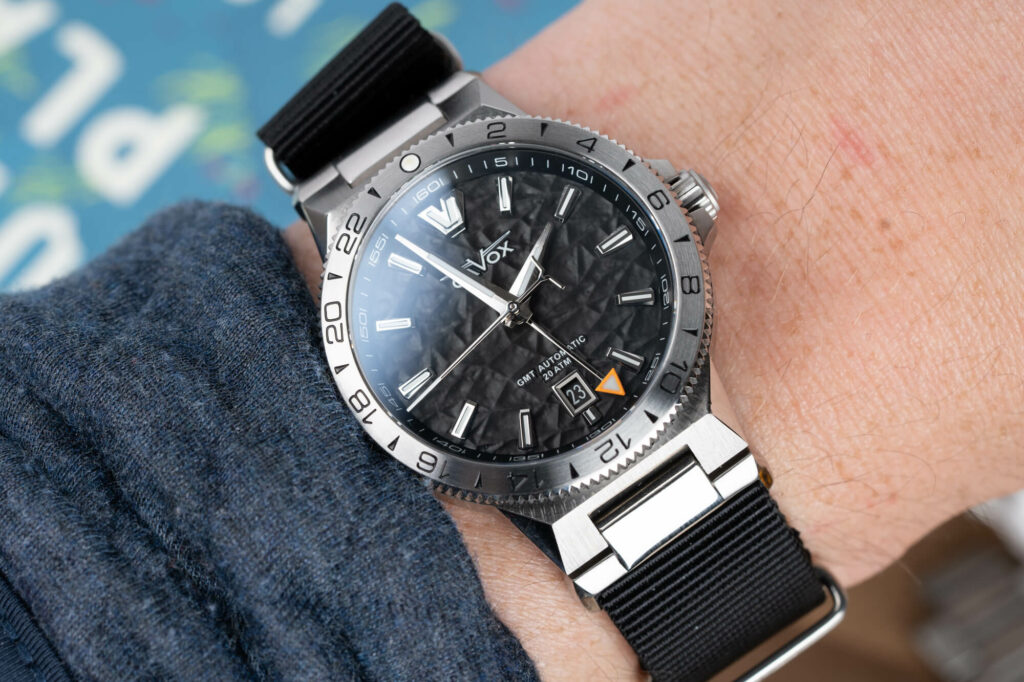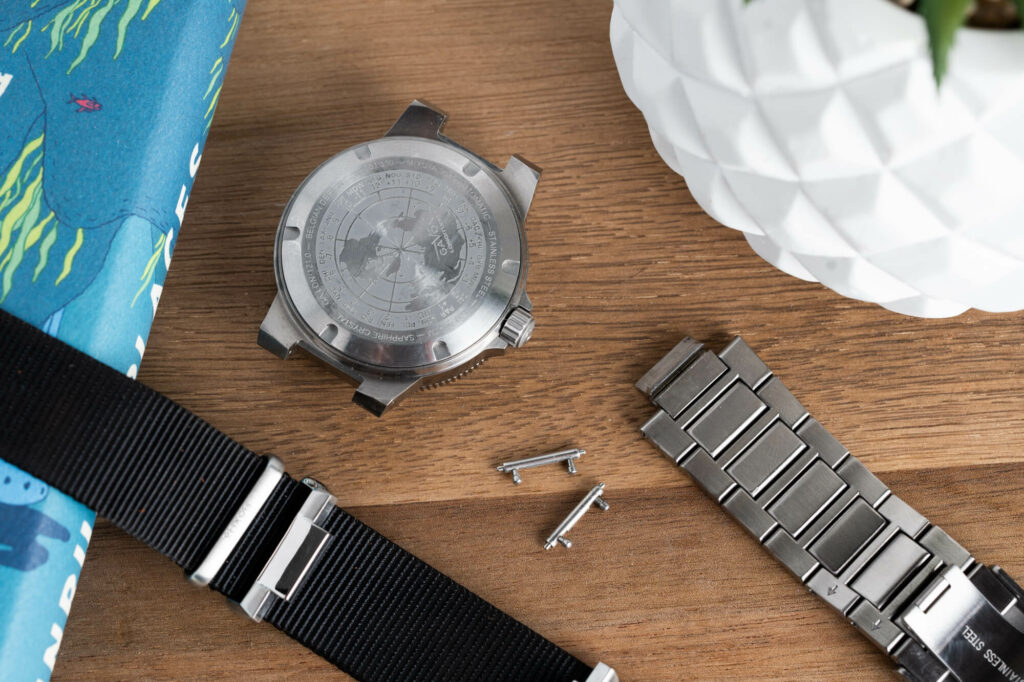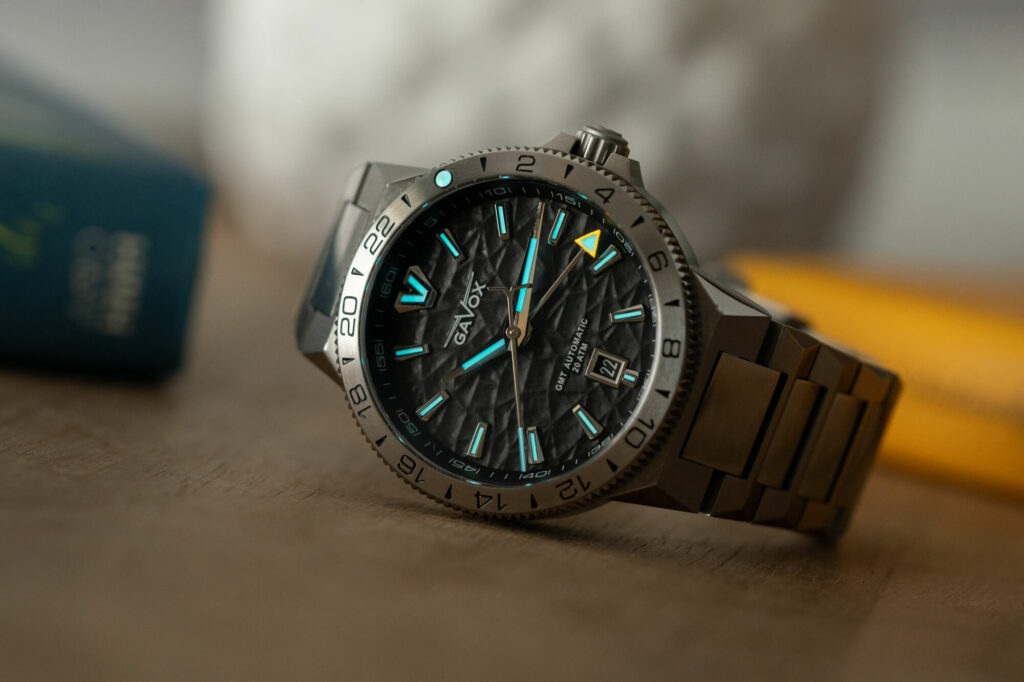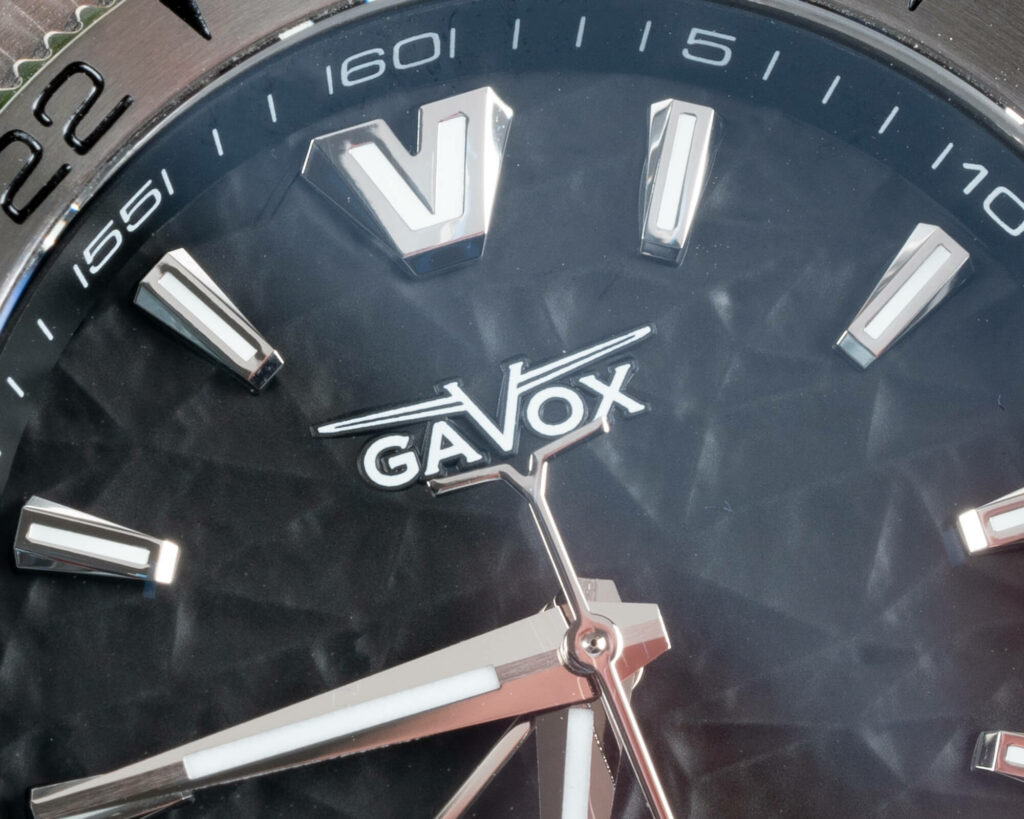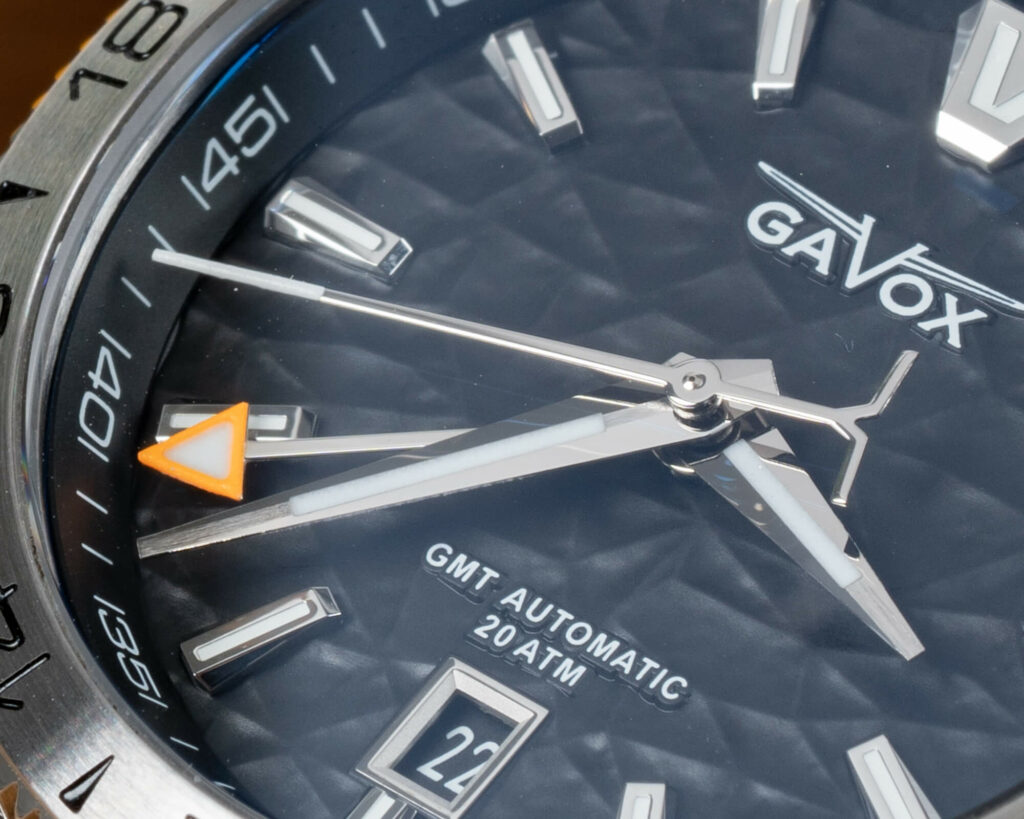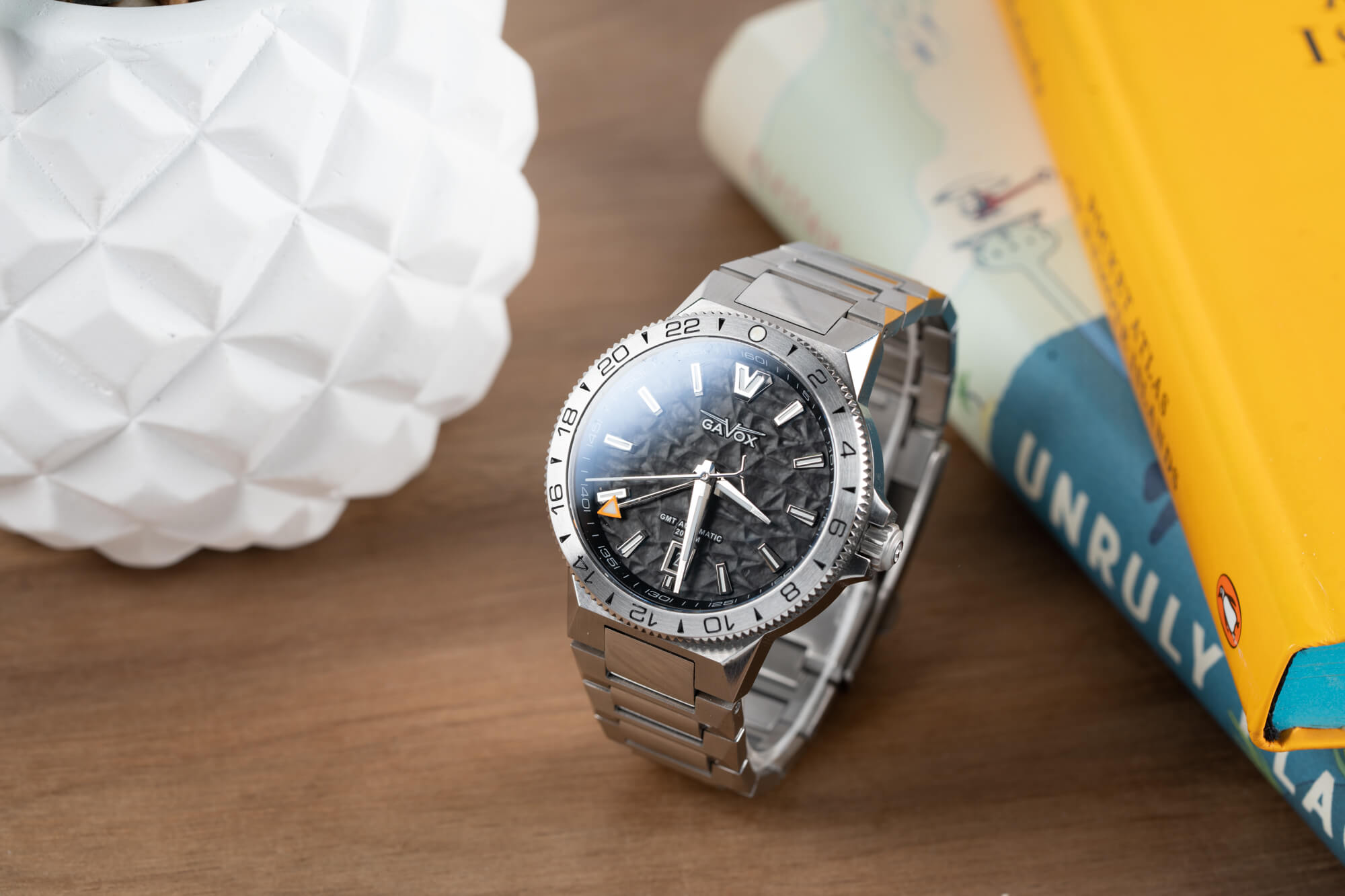 GMT watches are available by the truckload. With the recent releases of automatic GMT movements from both Seiko and Miyota, any brand can put one together, with or without any inspiration. But we don’t want or need another homage or boring GMT — it’s easy to phone in design these days, and adding a colorful GMT hand is one of the laziest ways to do it. The problem is one that every brand has to confront with every new model (after deciding not to make terrible watches, that is). How can we differentiate? As it becomes easier and easier to make a watch, and as more and more brands enter the fray, that question becomes harder and harder to answer satisfactorily. Belgian brand Gavox, though, seems to have found a novel groove with its newest model, the Gavox Longitude.
GMT watches are available by the truckload. With the recent releases of automatic GMT movements from both Seiko and Miyota, any brand can put one together, with or without any inspiration. But we don’t want or need another homage or boring GMT — it’s easy to phone in design these days, and adding a colorful GMT hand is one of the laziest ways to do it. The problem is one that every brand has to confront with every new model (after deciding not to make terrible watches, that is). How can we differentiate? As it becomes easier and easier to make a watch, and as more and more brands enter the fray, that question becomes harder and harder to answer satisfactorily. Belgian brand Gavox, though, seems to have found a novel groove with its newest model, the Gavox Longitude.
The Gavox Longitude steps away from its brand siblings, which are split between dress watches with quirky layouts and steel white-on-black tool watches, all in run-of-the-mill cases. The 39mm steel case of the Longitude, however, leaves that mundaneness behind in favor of a faceted lug design and a blend of polishing and brushing that brings the watch to life. Its small but prominent crown guards keep the screw-down crown protected, while the bi-directional 24-hour coin-edge bezel features a lume pip and allows you to track a third time zone if you’re so inclined. The watch gets an AR-coated sapphire crystal, 200 meters of water resistance, and a Kolsterising treatment that increases the case’s hardness to make it almost immune to scratches. If shiny steel isn’t your jam, there’s also a blacked-out DLC Longitude the brand calls “Black Diamant.”
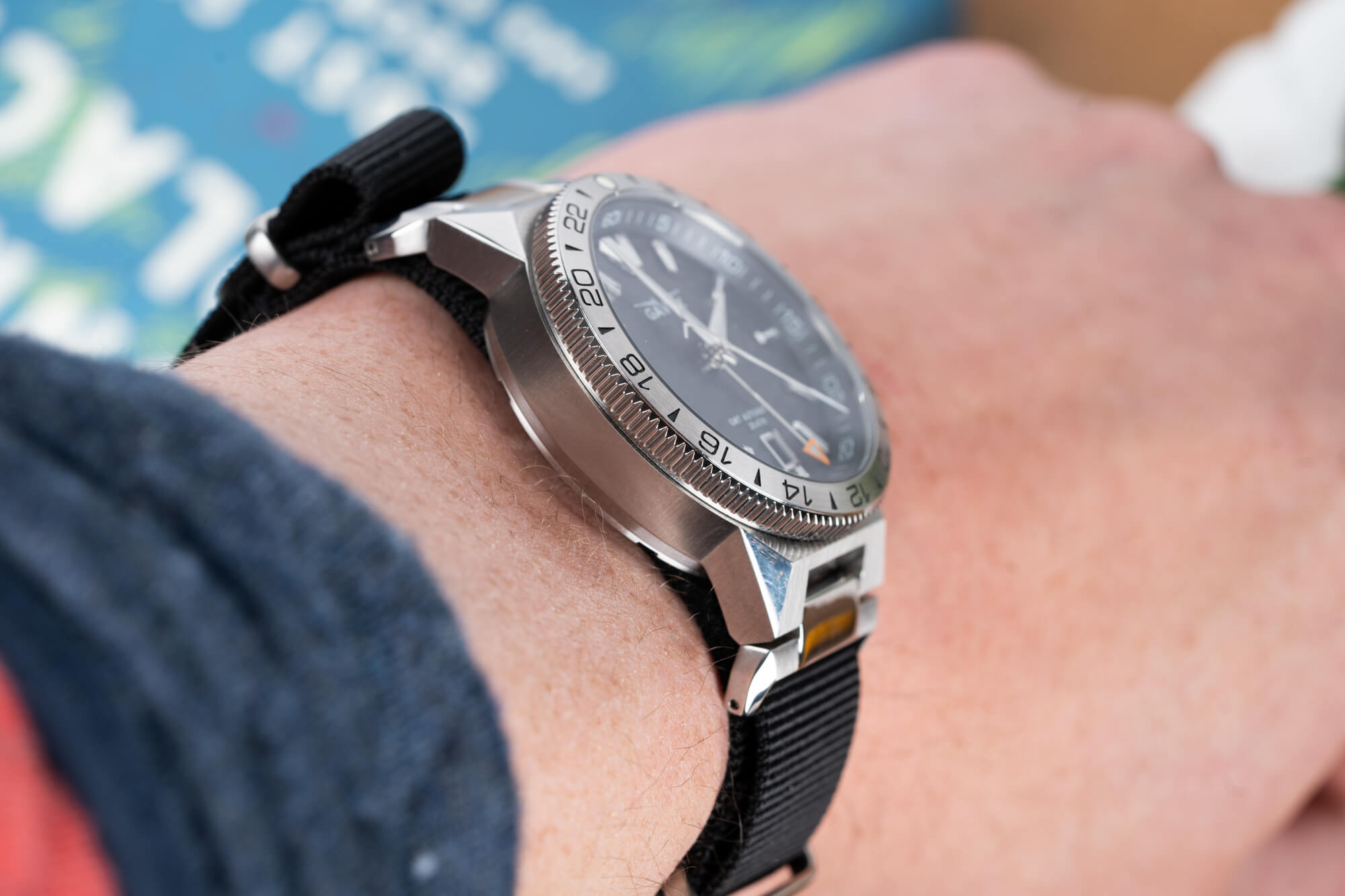 The Longitude’s case is undeniably blocky. 39mm is a great case diameter, but the 12.8mm height means it sits tall relative to its width. That stockiness is reinforced by the modest 43mm lug-to-lug. The chunky faceted lugs don’t really do much, if anything, to mitigate this. With all that, I still didn’t mind how it sat on my seven-inch wrist, especially with a jacket or long sleeves. The vertical brushing on the mid-case and side of the lugs is a nice touch and adds further differentiation from more generic case designs. The real standouts, though, are the design and engineering of the bracelet. The links of the bracelet mimic the design of the lugs, with big, bold polished and brushed facets paired with smooth polished center links. The closure is a simple folding clasp that keeps the bracelet from becoming overwhelming. No built-in micro-adjustment mechanism here, but a few notches will afford some flexibility, and the clasp is easy to operate and secure.
The Longitude’s case is undeniably blocky. 39mm is a great case diameter, but the 12.8mm height means it sits tall relative to its width. That stockiness is reinforced by the modest 43mm lug-to-lug. The chunky faceted lugs don’t really do much, if anything, to mitigate this. With all that, I still didn’t mind how it sat on my seven-inch wrist, especially with a jacket or long sleeves. The vertical brushing on the mid-case and side of the lugs is a nice touch and adds further differentiation from more generic case designs. The real standouts, though, are the design and engineering of the bracelet. The links of the bracelet mimic the design of the lugs, with big, bold polished and brushed facets paired with smooth polished center links. The closure is a simple folding clasp that keeps the bracelet from becoming overwhelming. No built-in micro-adjustment mechanism here, but a few notches will afford some flexibility, and the clasp is easy to operate and secure.
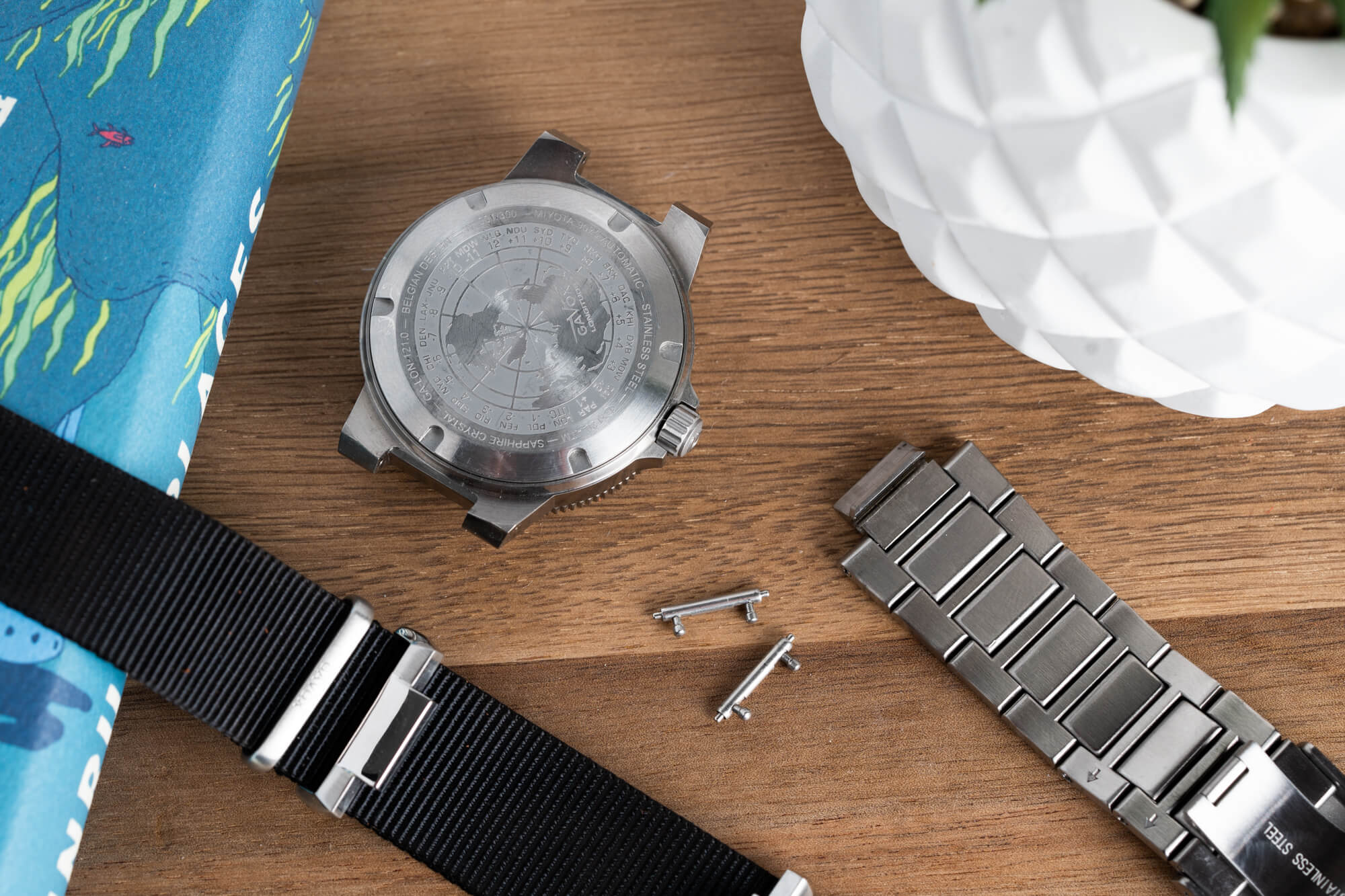 The bracelet’s end links are effectively the final center links and have a channel into which slots a very short double-tabbed quick-release spring bars. I found the tabs difficult to grip and a bit frustrating; perhaps more nimble fingers won’t have the same issue, but I’ve seen this on one or two other watches and didn’t like it then, either. I imagine there are cost savings here: Instead of developing or licensing some proprietary quick-release mechanism for the small end links, or having the bars built into them, using a channel allows the bars to be used for the bracelet and the included adapters. The adapters come attached to a ho-hum black NATO-style strap, but are removable, allowing you to pair the watch with any 20mm strap. In my limited experimentation, it looks very weird with a strap, as it extends the case awkwardly and makes any strap seem longer than it actually is. I’d keep this one on the bracelet. [Note: After the initial review was published, the brand owner got in touch to let me know the slide-out spring bars were scrapped in favor of fixed quick-release spring bars.]
The bracelet’s end links are effectively the final center links and have a channel into which slots a very short double-tabbed quick-release spring bars. I found the tabs difficult to grip and a bit frustrating; perhaps more nimble fingers won’t have the same issue, but I’ve seen this on one or two other watches and didn’t like it then, either. I imagine there are cost savings here: Instead of developing or licensing some proprietary quick-release mechanism for the small end links, or having the bars built into them, using a channel allows the bars to be used for the bracelet and the included adapters. The adapters come attached to a ho-hum black NATO-style strap, but are removable, allowing you to pair the watch with any 20mm strap. In my limited experimentation, it looks very weird with a strap, as it extends the case awkwardly and makes any strap seem longer than it actually is. I’d keep this one on the bracelet. [Note: After the initial review was published, the brand owner got in touch to let me know the slide-out spring bars were scrapped in favor of fixed quick-release spring bars.]
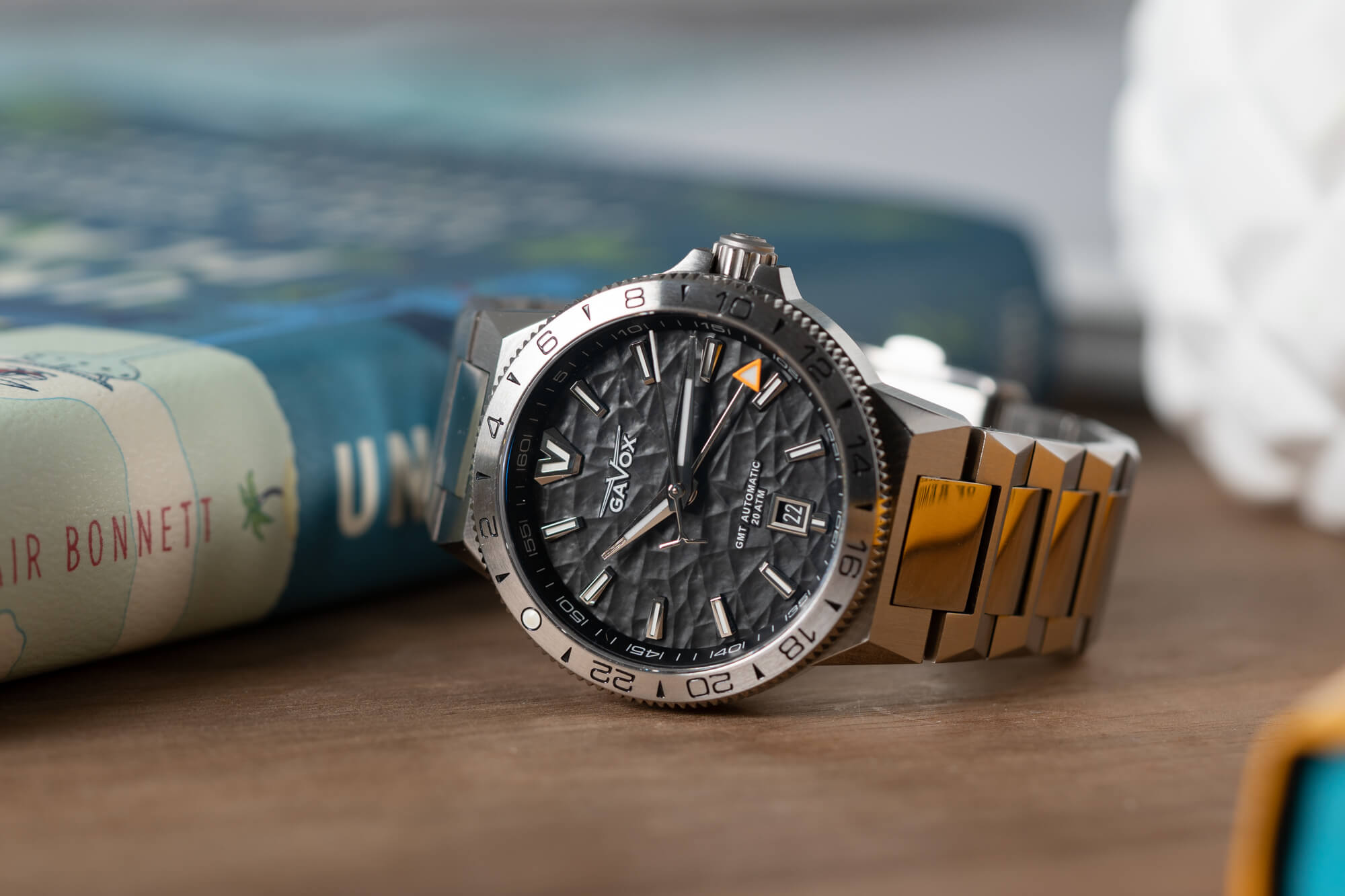
Perhaps as exciting as the fresh case is the remarkable textured dial. When I first saw renders of the dial, I was immediately reminded of the dimpled dials on the newest Audemars Piguet Royal Oak Flying Tourbillons. On closer inspection, this is not that, but it’s also not trying to be (the pre-order for the Longitude was opened up months before the APs were even announced). Available in turquoise, blue, or the gray seen here, the dial has a texture that is meant to recall the texture of the rolling sea, though my initial impression was of crumpled construction paper.
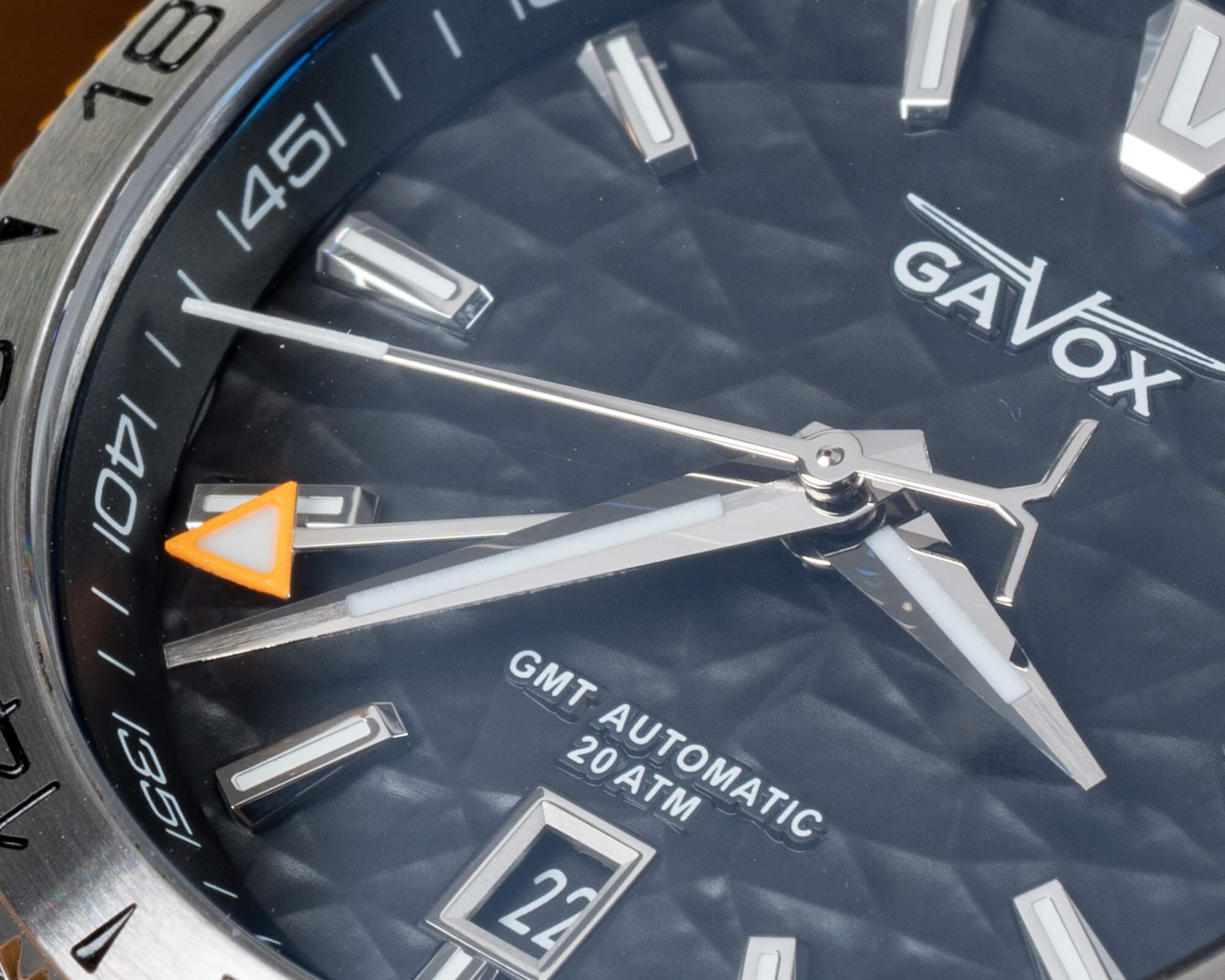 The model’s name and its wave-like dial make sense, though. Gavox Founder Michael Happé’s forebear was a Dutch navigator in the 1600s before one could accurately determine a ship’s exact position at sea. At the time, one could use the sun to determine latitude, but determining longitude was a dangerously vague undertaking. When Englishman John Harrison developed the marine chronometer in the next century, it allowed oceangoing crews to determine their precise longitude based on the clock set to Greenwich Mean Time (now UTC) and the local time, which could be determined by solar or astronomical observation.
The model’s name and its wave-like dial make sense, though. Gavox Founder Michael Happé’s forebear was a Dutch navigator in the 1600s before one could accurately determine a ship’s exact position at sea. At the time, one could use the sun to determine latitude, but determining longitude was a dangerously vague undertaking. When Englishman John Harrison developed the marine chronometer in the next century, it allowed oceangoing crews to determine their precise longitude based on the clock set to Greenwich Mean Time (now UTC) and the local time, which could be determined by solar or astronomical observation.
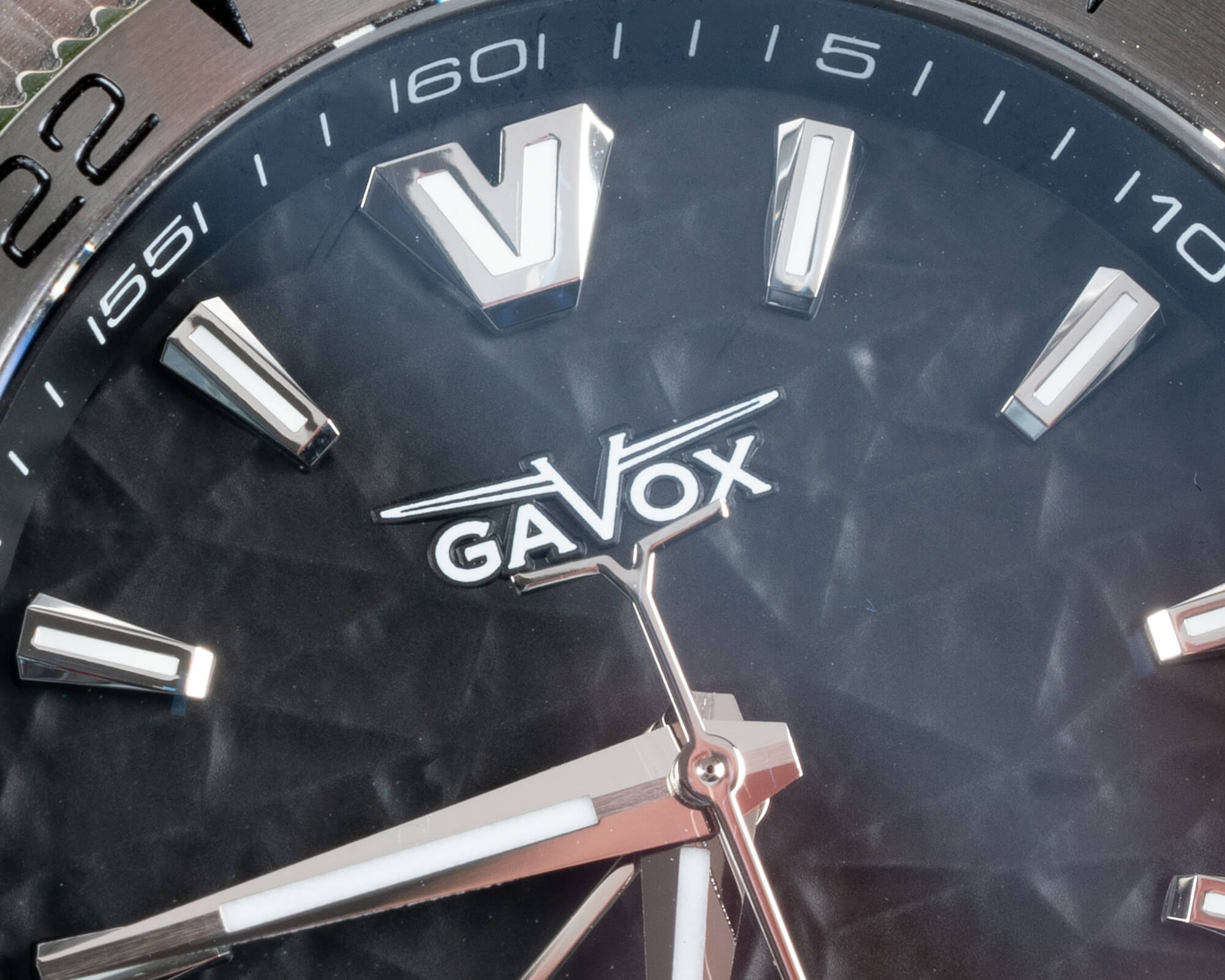 The dial is appointed with beveled applied hour markers, with the 12 o’clock marker echoing the fuselage ‘V’ in the Gavox logo (the logo represents a plane, as the brand got its start making aviation-inspired watches). The markers repeat the faceting of the case and are complemented by the hands, which feature brushed tops and polished flanks. One of my favorite features of the watch is the counterbalance on the seconds hand, which lines up perfectly with the logo (and the 12 o’clock marker). They all get a healthy dose of Super-LumiNova BGW9 for a cool blue-green glow in low light. (Were it not for the contrasting lume strips in the hands, they might get lost in any light.) The GMT hand is given the spotlight with its orange triangle border. At 6 o’clock, a framed date window eats into the applied marker a bit but doesn’t cause any consternation; the date wheel is color matched to each dial to minimize disruption.
The dial is appointed with beveled applied hour markers, with the 12 o’clock marker echoing the fuselage ‘V’ in the Gavox logo (the logo represents a plane, as the brand got its start making aviation-inspired watches). The markers repeat the faceting of the case and are complemented by the hands, which feature brushed tops and polished flanks. One of my favorite features of the watch is the counterbalance on the seconds hand, which lines up perfectly with the logo (and the 12 o’clock marker). They all get a healthy dose of Super-LumiNova BGW9 for a cool blue-green glow in low light. (Were it not for the contrasting lume strips in the hands, they might get lost in any light.) The GMT hand is given the spotlight with its orange triangle border. At 6 o’clock, a framed date window eats into the applied marker a bit but doesn’t cause any consternation; the date wheel is color matched to each dial to minimize disruption.
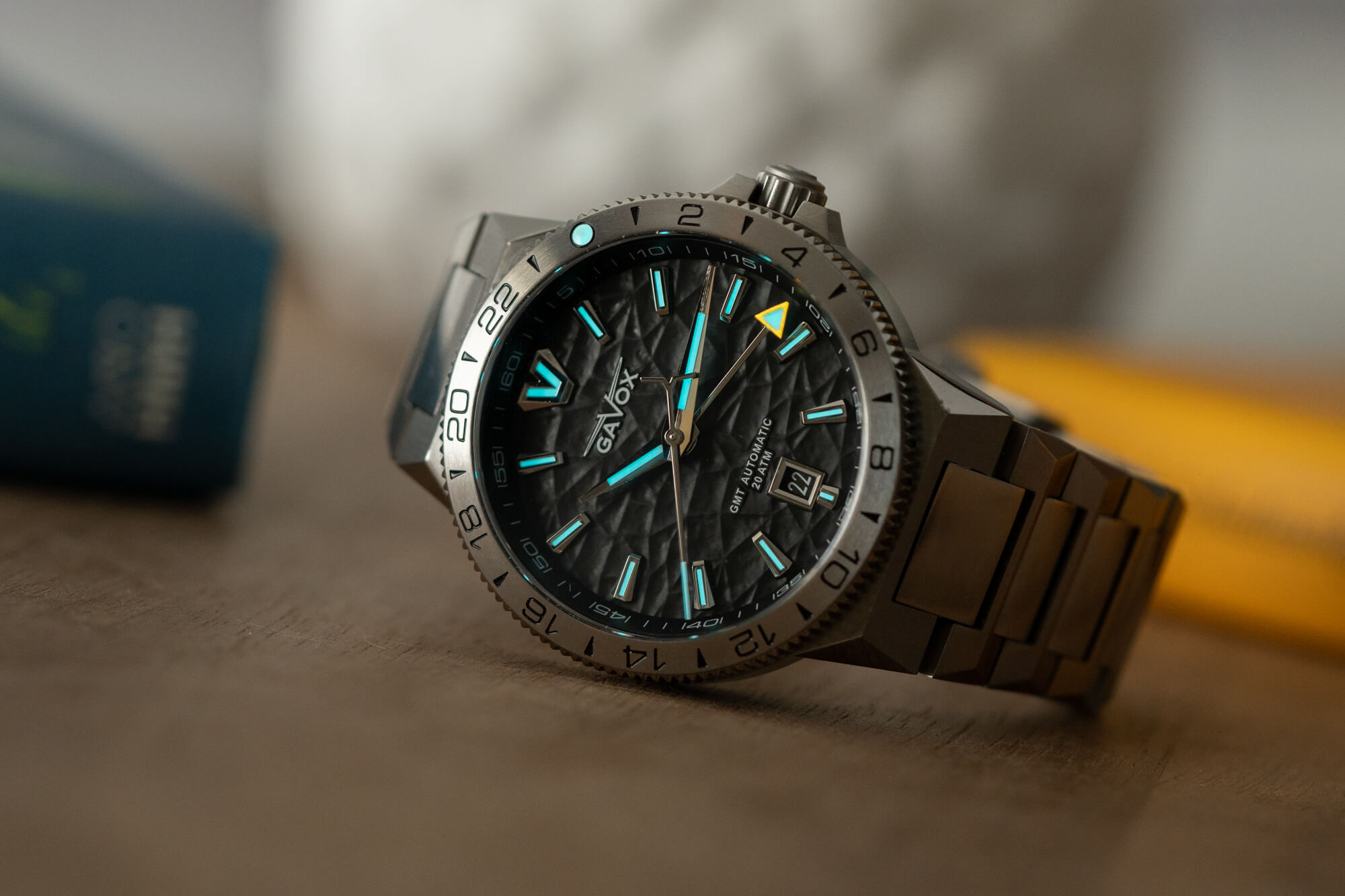 The Longitude gets its mojo from the new automatic Miyota 9075 GMT caliber. Unlike Seiko’s new NH34 GMT movement, the 9075 features an independent hour hand instead of an independent 24-hour hand. The Miyota’s functionality is generally preferred amongst the watch illuminati, but there’s no better or worse here, just different. The first crown position winds the watch, the second adjusts the 24-hour hand, and the third sets the time. Of note, there is no quick-set date in these “flyer” GMT calibers; the date is advanced by swinging the hour hand around with the crown in its second position (which is admittedly more entertaining than it should be). The 9075 operates at 28,800 vph with a power reserve of around 42 hours. It features hacking and a unidirectional winding system, which means the occasional whirring of the rotor as it spins freely in the unengaged direction. Some people avoid Miyota movements solely because of this noise, but I’ve never been bothered by it; on the contrary, I always brighten up when I accidentally set the rotor spinning.
The Longitude gets its mojo from the new automatic Miyota 9075 GMT caliber. Unlike Seiko’s new NH34 GMT movement, the 9075 features an independent hour hand instead of an independent 24-hour hand. The Miyota’s functionality is generally preferred amongst the watch illuminati, but there’s no better or worse here, just different. The first crown position winds the watch, the second adjusts the 24-hour hand, and the third sets the time. Of note, there is no quick-set date in these “flyer” GMT calibers; the date is advanced by swinging the hour hand around with the crown in its second position (which is admittedly more entertaining than it should be). The 9075 operates at 28,800 vph with a power reserve of around 42 hours. It features hacking and a unidirectional winding system, which means the occasional whirring of the rotor as it spins freely in the unengaged direction. Some people avoid Miyota movements solely because of this noise, but I’ve never been bothered by it; on the contrary, I always brighten up when I accidentally set the rotor spinning.
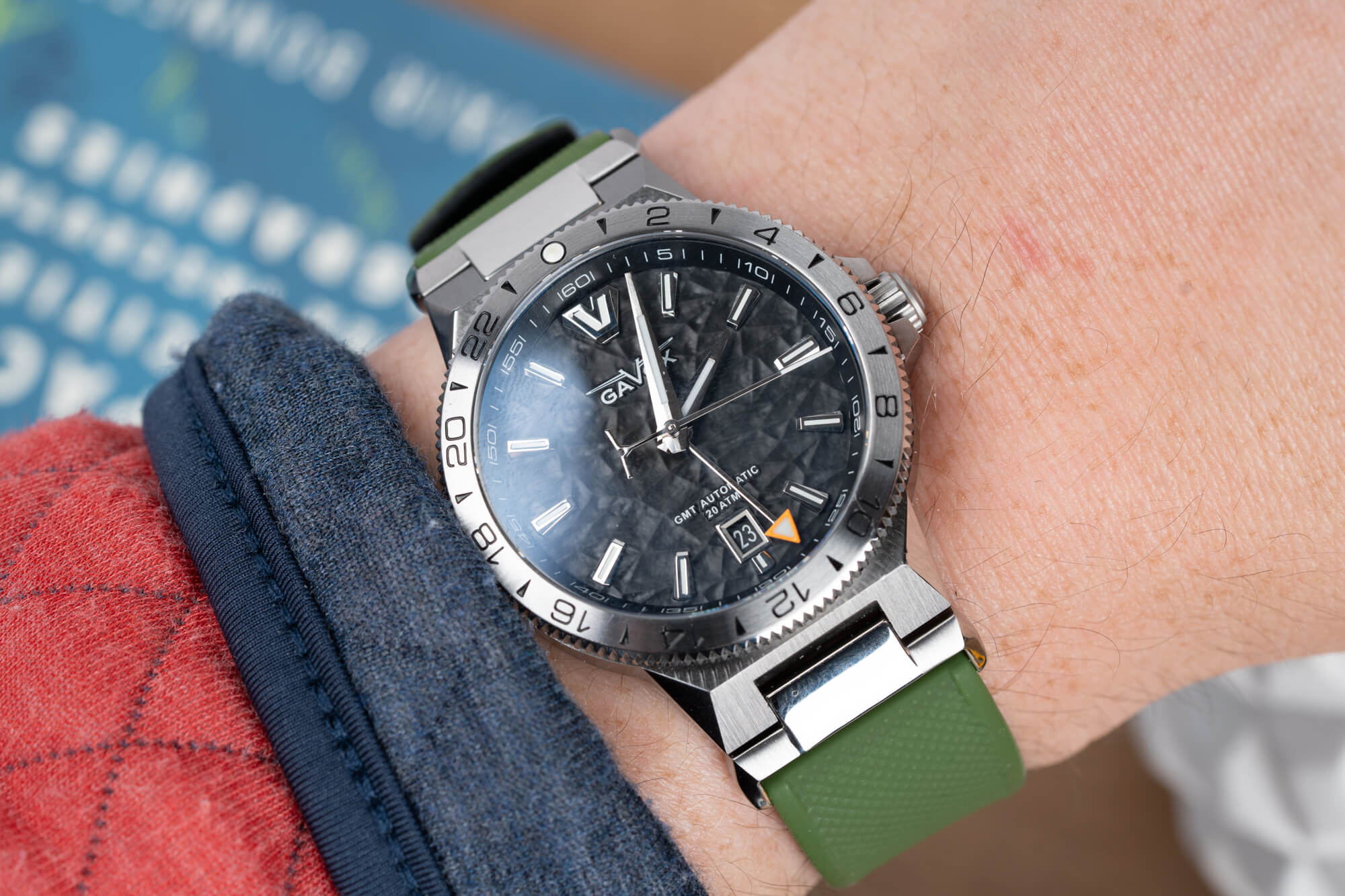
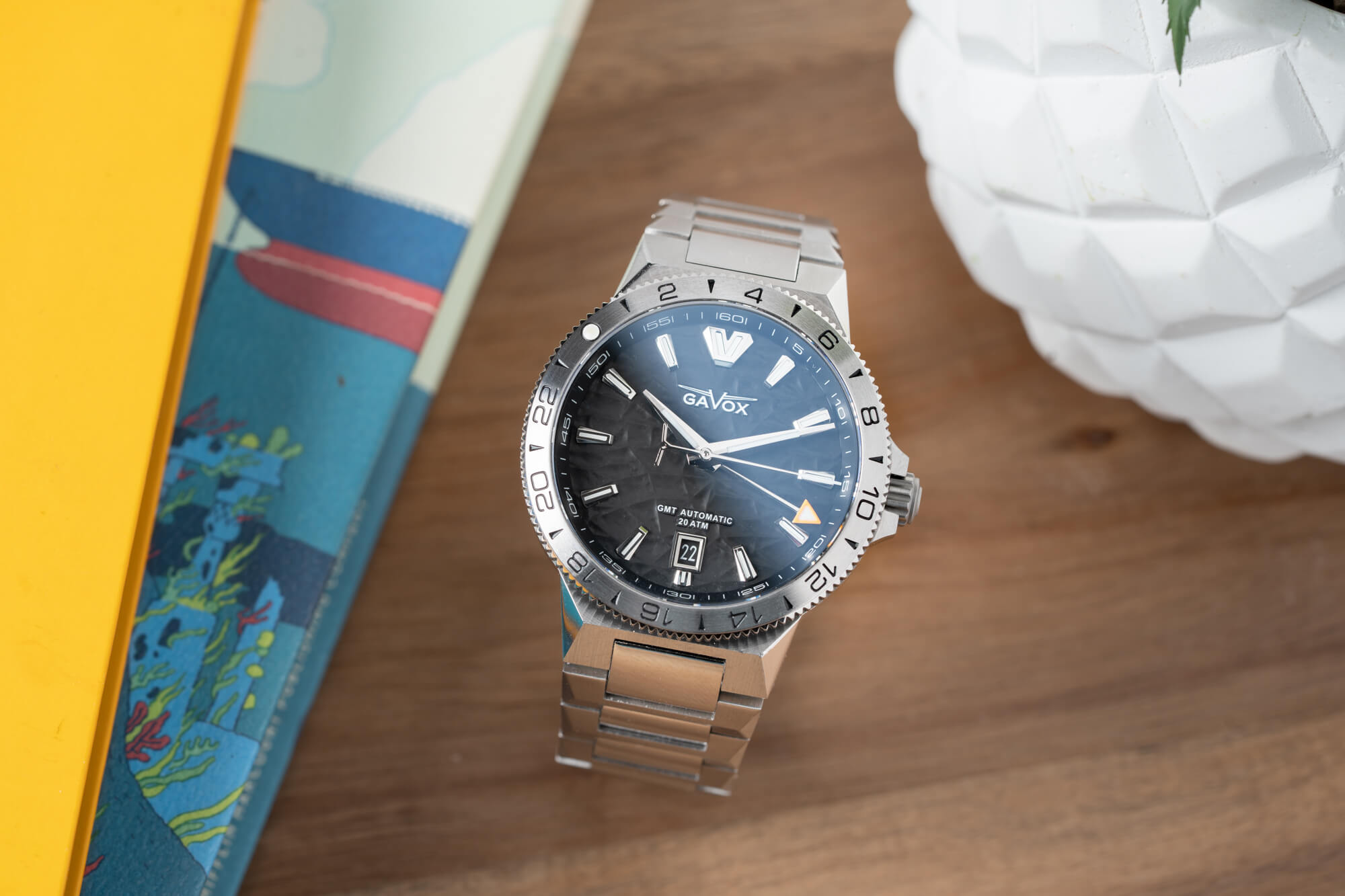
The Gavox Longitude is priced at $1,118 USD (excluding VAT), making it the brand’s most expensive watch to date. But it’s also the most exciting watch it’s made. If you look at the Longitude within the context of the larger Gavox catalog, it stands out for its colorful, textured dial, its faceted case, and its angular bracelet. There are some brands that release a new model and the collective response is (and should be), “What the hell?” Those models are inexplicably divergent while adding nothing to the brand. But the Gavox Longitude seems to mark an exciting new chapter for the Belgian brand, one hopefully filled with designs that continue to push the envelope and move beyond the white print, black dial watches that have so far defined it. For more information, please visit the brand’s website.
Necessary Information:
>Brand: Gavox
>Model: Longitude
>Price: $1,118 USD ($1,158 USD for the all-black version)
>Size: 39mm-wide, 12.8mm-thick, 43mm lug-to-lug distance
>When reviewer would personally wear it: To make a statement to all my microbrand friends
>Friend we’d recommend it to first: Someone looking for a more interesting GMT than your typical fare
>Best characteristic of watch: Dial and case design
>Worst characteristic of watch: Chunky case proportions, strap limitations (even with the adapters)

